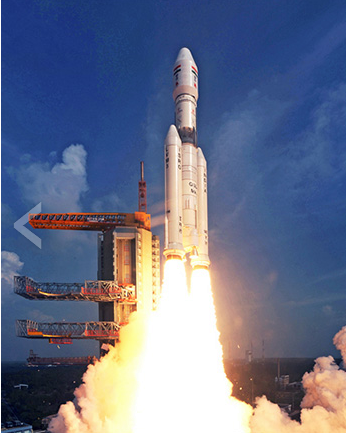I have posted a series of blogs about the history of India's space program. There have been problems and delays partially due to the limited budget that India can devote to its space program. They have developed much of their own space technology from scratch. They are accomplishing amazing things on a fraction of the budget of other space programs. Their recent Mars probe cost about one tenth of the recent NASA Mars probe. Despite their success with launching small satellites, until now they have not been able to launch the heavier loads needed for manned spaceflight. Recently India has been in the news because of a new rocket that they launched that can double the weight of Indian payloads.
The Indian Space Research Organization (ISRO) three-stage Geostationary Satellite Launch Vehicle (GSLV) Mk-III rocket weights six hundred and thirty tons. It can carry a payload of four tons into orbit. The rocket was developed to carry heavy communication and scientific satellites into orbit as well as manned space capsules. For the initial test, only the first two stages carried active engines that ignited. The first stage consisted of two solid-state engines. Each of these engines can generate up to two hundred tons of thrust. They are the third largest rocket boosters in the world. The third stage carried a cryogenic engine in passive mode.
The first test launch carried an uncrewed manned space capsule to an altitude of about eighty miles. Twenty minutes after launch, the crew capsule separated and, using its own engines, re-entered the atmosphere at high velocity. The capsule successfully splashed down in the Bay of Bengal. Part of the test program had to do with testing the performance of the capsule's heat shield against the seventy two hundred degrees Fahrenheit re-entry temperatures.
When crewed, the capsule will carry up to three astronauts into orbit. ISRO has estimated that it may take up to seven years to ultimately launch a crewed capsule with the new rocket. The ISRO has requested about one billion nine hundred million dollars for the manned space program. If India can successfully developed a manned space program, it will be the forth country to put men into space. The U.S., Russia and China are the only other countries that currently have the ability to launch manned spaceflights.
The next step is the development of a new cryogenic rocket engine in India to replace the European engine that was used to test the GSLV rocket. India wants to expand its market share of an estimated three hundred billion dollar international space marketplace. Major space powers such as the U.S., Russia, China and the European Union are currently engaged in a thriving business launching satellites for other countries. India hopes to be able to launch its own communication satellites and manned missions with the new rocket as well as launch satellites for other countries.
Geostationary Satellite Launch Vehicle:
